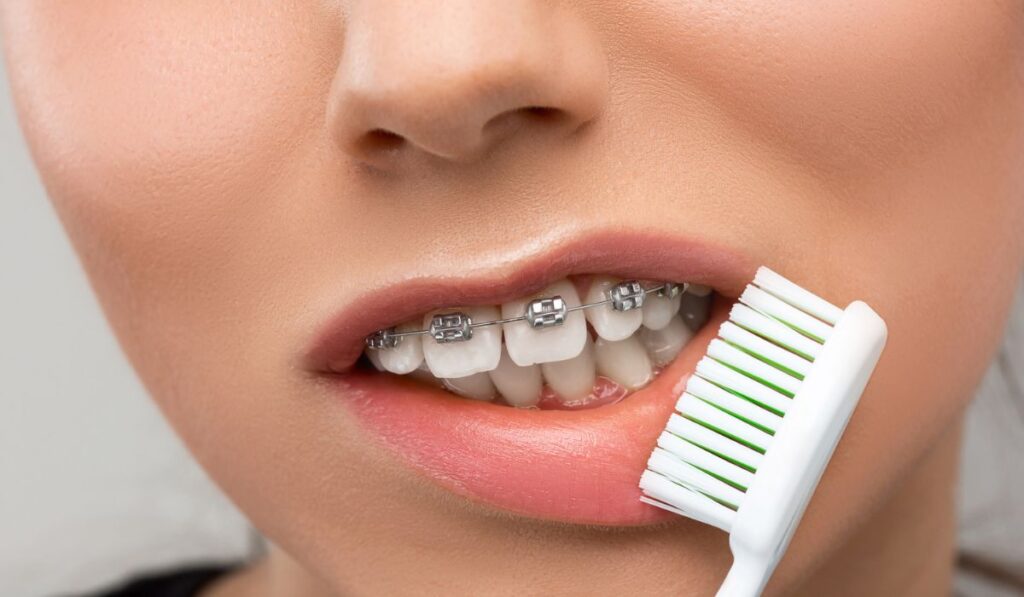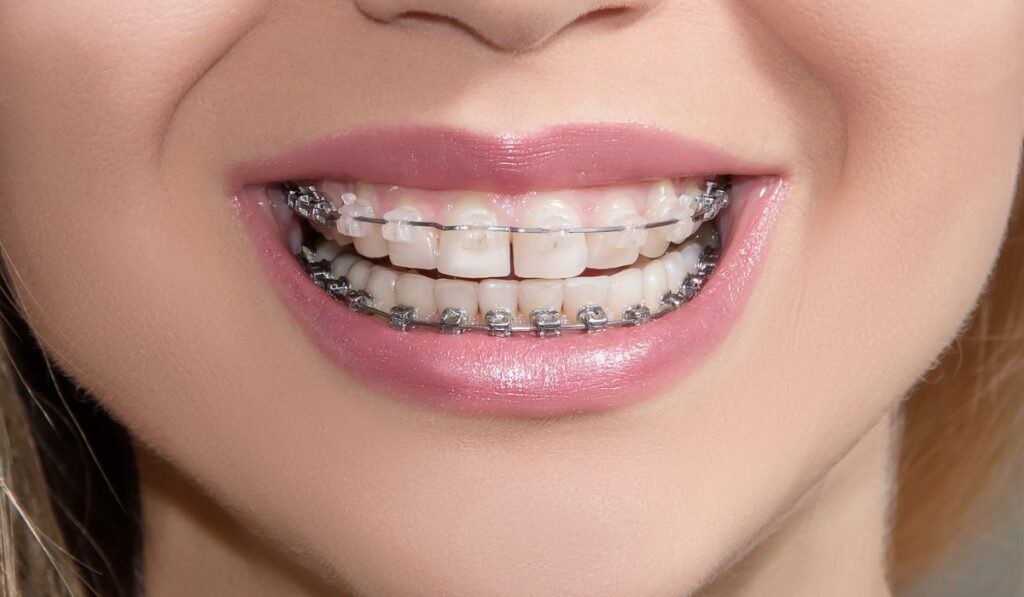You might notice new gaps between your teeth during or after braces treatment. These spaces can be alarming, especially if you didn’t expect them and aren’t sure why they’re there. So, what causes gaps after braces, and how can you prevent them?
Gaps during braces treatment are part of the process. Gaps after braces are typically the result of improper retainer use or disregarding aftercare guidelines. Be sure to wear your retainer as recommended, and consult your orthodontist regularly.
Don’t panic just yet if you’re concerned about gaps after having your braces removed. Following your orthodontist’s instructions, proper oral care, and wearing your retainer can help you from developing new gaps. Here’s everything you need to know.
Can Braces Cause a Gap in Your Teeth?

You might notice new gaps in between your teeth during your braces treatment. New gaps can be alarming. After all, aren’t braces supposed to realign your smile instead of making things worse? Thankfully, gaps from braces are typically temporary and part of the readjusting process.
Imagine realigning your teeth as a home cleaning project. You need to move stuff around to clean and straighten one area. The cleaning project might look messy at first before things are rearranged and put back in order. Your teeth are much the same.
New gaps or spaces developing between teeth during braces treatment are part of the adjustment process and will usually close as the treatment progresses. In fact, gaps are a sign that the braces are working properly and readjusting your teeth to form a straighter smile.
Why Did You Get a Gap With Braces?
There are several causes for new gaps during braces treatment or after. Here are some of the reasons why you might have developed a gap between your teeth with braces.
You Didn’t Use a Retainer
You might be excited to finally have your braces removed. However, the orthodontic treatment doesn’t completely end after your braces are taken off. Braces are used to correct your bite and realign your teeth.
But after the braces are removed, the teeth need to be held in their new position for a certain time frame. Dentists will provide you with a retainer to hold these new positions, so that the teeth don’t shift around.
You might experience shifting teeth and a misaligned smile if you don’t wear your retainer as directed after removing your braces.
You Stopped Wearing Your Retainer Early
It’s easy to overlook wearing your retainer after having your braces removed. You might want to enjoy your new smile, be fed up with the treatment, or think nothing bad will happen. Unfortunately, not wearing your retainer as prescribed can lead to dental issues such as gaps and shifting teeth.
For those reasons, it’s crucial to follow all of your orthodontist’s recommendations and wear your retainer as prescribed.
Gaps From Extractions
In some cases, you might experience new gaps or spaces after having a tooth extracted, even if you’ve had braces. Although these cases are rare, they can occur with tooth extractions near the back of your mouth. Be sure to follow all of your orthodontist’s recommendations to avoid gaps or spaces.
Removing Braces Too Early
As you might expect, removing your braces too early can cause gaps to persist or develop. Braces are used to correct and realign your teeth. Gaps can persist or develop if the treatment doesn’t go according to plan.
Skeletal Issues
In some cases, skeletal issues can cause gaps to develop or persist. Skeletal malocclusion is a condition caused by bone problems in the jaw resulting in misaligned, protruding, or retruding teeth. Skeletal issues typically need surgical treatment and might include braces.
However, avoiding surgical treatment and opting for braces alone can cause issues down the line. Gaps may develop even years after you have your braces removed. Your teeth might shift into their old position, causing spaces to develop or persist.
How to Prevent Gaps After Braces?
Don’t panic just yet if you’re concerned about gaps after having your braces removed. Fortunately, there are multiple steps you can take to prevent gaps from developing or persisting after having your braces removed.
Wear Your Retainer as Recommended
As you might have guessed, the best way to prevent gaps from developing after braces is by wearing your retainer as recommended. Be sure to follow all of your orthodontist’s guidelines, regardless of how frustrating they might be. Consult your orthodontist if you have any issues, questions, or painful symptoms.
Treat Your Teeth Well
It’s tempting to use your teeth as a makeshift tool to open bags or containers. Unfortunately, using your teeth in this way can cause damage in the long run. You can avoid gaps or dental damage by using your teeth for their intended purpose. Opt for scissors to open difficult bags or packages. Avoid chewing on pens, pencils, or non-edible objects.
Practice Good Oral Hygiene
Braces and retainers are used to realign your smile. But the treatment doesn’t end there, and you’ll still need to practice good oral hygiene techniques. Poor oral hygiene can lead to gum disease, dental decay, shifting teeth, and other serious health complications.
Be sure to brush and floss your teeth at least twice daily. Brush your teeth for at least two minutes each time using a soft-bristle toothbrush (on Amazon). You can consult your dental team to determine which products are best for your circumstances.
You Might Need Braces Again
Unfortunately, you might need a second pair of braces to fix new or persisting gaps. Although frustrating, this might be necessary to realign your smile. Severe gaps and spaces might occur from dental damage or not following orthodontist’s guidelines, such as wearing a retainer.
Your orthodontist might use various dental procedures such as power chains or springs to close the gaps and correct your smile. Be sure to consult with your dental professional to determine what’s best for your situation.
Regularly Consult Your Dental Team
Be sure to regularly consult your orthodontist and dental team during braces treatment. Reach out to your dentist if you notice shifting teeth, painful symptoms, or your retainers aren’t working correctly. Getting treatment in a timely manner will ensure you aren’t developing any new gaps or dental damage.
Can Braces Fill Gaps Between Teeth?

There are several treatment options and plans for correcting gaps between teeth, including braces. These treatment plans will be conducted by a licensed orthodontist who’s experienced with these issues. Here are the basics of how braces work to correct gaps between teeth.
How Braces Work
Braces are one of the most effective, convenient, and affordable treatment options for correcting spaces between teeth. You can receive braces in different options, including metal, ceramic, and lingual, depending on the circumstances.
Braces and aligners apply constant pressure to your teeth and jaw to realign your smile over time. The soft tissue and ligaments surrounding the teeth stretch and compress as teeth move, forming new bone structures in the process. However, this process happens in stages.
The First Stage
Skeletal discrepancies might become apparent during the beginning stages of braces treatment. You might notice new gaps, overbites, or other issues and become concerned that the braces aren’t working correctly. However, all of these changes are normal and to be expected.
Leveling the Arches
Your orthodontist will level the arches of your teeth after the initial aligning and crowding have been repaired. This process creates a normal curve to your upper and lower teeth and achieves your upper and lower arches into the correct angles. Your treatment will vary depending on the exact circumstances.
Open Bite and Deep Bite Treatment
Next, your orthodontist will adjust your braces to correct any bite complications, including an overbite, underbite, or crossbite. You might require repairs to vertical issues to ensure both arches match up correctly. Gaps are typically closed during this phase of the treatment plant.
The Final Stage: Correcting the Overbite
Finally, you’ll have your teeth fine-tuned and adjusted. You might have your overbite or underbite strained out or improved during this stage. Your orthodontist might use rubber bands, extractions, or other tools to achieve any adjustments necessary.
Other Treatment Options
There are other treatment options available for fixing gaps besides traditional braces. You might have these treatments instead of braces or afterward to resolve any lingering issues. Here are some of the treatment options for realigning teeth and removing gaps.
Invisalign Clear Aligners
Invisalign clear aligners can be an effective, reliable, and comfortable treatment option for resolving gaps between teeth. Invisalign treatments can typically be used in place of braces and are just as successful. These treatment options can be less invasive and don’t require unsightly metal in your mouth, making them a popular choice for adults and teens alike.
Dental Bonding
In some cases, dental bonding is required to fully close gaps between teeth. Dental bonding is usually used to fill gaps between very small teeth after previous orthodontic treatment. The bonding material is a composite resin that matches the hue of your natural teeth.
The dentist will apply the bonding solution to your tooth by creating a rough surface on your tooth, making it easier for the bonding agent to adhere. The dentist will mold the composite resin to the area and fill in any gaps or damages before drying it with a UV light.
The teeth need to be adequately positioned for the bonding procedure to be effective, meaning you might need braces or aligners beforehand.
Conclusion
Gaps during braces treatment are typically part of the process and nothing to worry about. New gaps can form during treatment due to your teeth shifting and realigning to the correct position.
However, you also might develop gaps if you don’t follow proper aftercare procedures after having your braces removed.
Be sure to consult your orthodontist regularly, wear your retainer, and follow all of the aftercare guidelines to avoid any new or persisting gaps between teeth.


